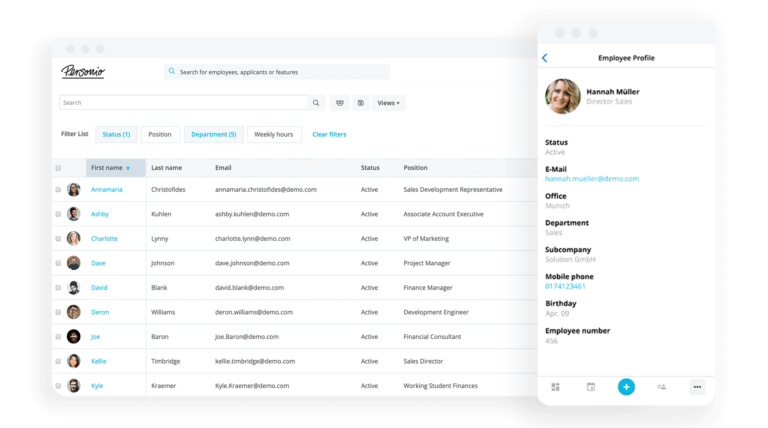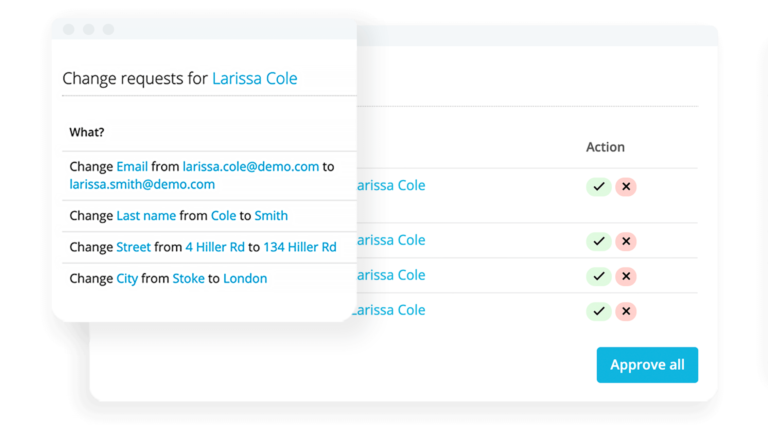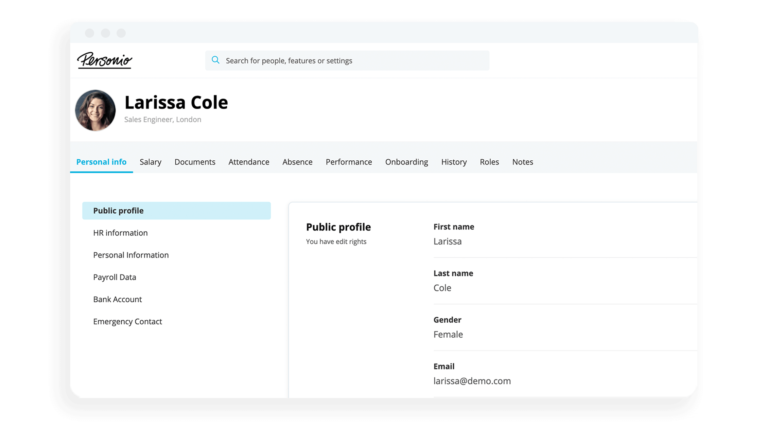People Workflow Automation unlocks your company’s productive potential, by turning manual processes into automated workflows that connect tools, align stakeholders, and accelerate business like never before.
Digital Personnel File
All Data
In One Place


Centralized Access To All
Documents and Data
Important Dates
Always Present


Fully Compliant Employee
Data Management

Your Personal Web Demo
Want to know if Personio can help your teams? Our experts will guide you through the platform in a free demo, tailored to your exact business needs.
- Introduction to all product features
- Focus on the elements you’re interested in
- Answers to any questions you have
Book Your Free Demo
Is Your Company Ready To Introduce
Digital Personnel Files?
A digital personnel file, or a digital employee file, can help your people team take their work to the next level. That’s because it is a sustainable, secure, and successful way to store employee data. This way, whether you’re in the office or working remotely, you always have the information you need within only a few clicks. The result is greater access, greater efficiency, with the confidentiality you always need.
What Is A Digital Personnel File?
A digital personnel file is an electronically-stored collection of data related to a specific employee. It typically includes all data relevant to an employee’s service, contract, career, life, and health while at work. It is essentially any given employee, at a glance.
How Do Digital Personnel Files Work?
For many companies, having digital personnel files software is a step in the right direction. This is especially true when it comes to digitizing your HR, as you migrate all of your employee data into one central, secure, and digital location.
In fact, it reduces the drain on HR cost structures and generally yields a return on investment (ROI) in only 18 months! While costs may increase during the conversion process, they drop rapidly after the first six-to-nine months.
What Are Common Benefits Of Digital Employee Files?
Depending on where your company is currently at, here are just some of the benefits you can reap when you implement digital personnel files effectively:
- Save time (and costs): Especially when processing employee files.
- Get rid of the old boxes of paper: Be more sustainable, get more space, and save money instead of paying for expensive archiving space.
- Work more collaboratively: Benefit from cross-departmental process optimization.
- Use the data to get better and better: Gain insights at the click of a button and use it to create new, or improve existing, HR initiatives.
- Improved data security: Thanks to smart rights management systems.
- Manage, retain, or delete documents easily: In line with your relevant regional retention obligations.
- Trust that you have the right version: Easily see the relevant, updated documents.
- Allow employees to self-serve: You get more accurate data and save time at the same time.
- Trust that your data is secure: Thanks to Personio’s high levels of GDPR compliance and advanced rights-based systems.
- Retain (or delete) documents easily: In line with relevant retention obligations.
Why Digitize (or Optimize) Your Digital Personnel Files?
Most often, it’s to cut down on HR costs. Here are some numbers that are commonly used as proof of ROI:
- Costs for non-digitized employee file management: 90 cents per file, including archives and audit-compliant operations.
- Costs for digitized employee file management: 20 cents per file for ongoing digitalization.
Note: the costs listed above relate to ongoing operations within larger companies with an average of 4,000 employees.
Digital personnel file software also saves time and reduces HR workloads. This, in turn, allows you to give your qualified employees more time to do other important, but often neglected, areas of HR work.
Can Employees Update Their Own Digital Personnel Files?
So, not only can you set up new employee files easily and at just the click of a button, your employees can make updates as they see fit. That means that when things change, like a last name or address, it can be completed in seconds and with your HR department only needing to approve the changes.
Can Employee Files be Kept Electronically?
These days, most governments around the world are actively encouraging their citizens and corporations to retain documents in a digital format. For example, in the UK, HMRC is perfectly happy to accept digital copies of receipts when claiming expenses – as long as they are clearly readable, of high enough quality, and, most importantly, accessible as and when required.
What Documents Should Be In A Digital Personnel File?
Typically, an employee file will include everything from a CV and relevant recruitment-related information such as an employment contract, to documents related to salaries, tax, annual leave, benefits, performance, and even KPIs.
Consider some of the following:
- CVs
- Government/tax-related information such as P60s and even P45s
- Performance and development documentation
- Employee responses to surveys
- Recruiting information
- Benefits information – pension details, next of kin forms, stock options, etc.
- Medical and sick leave data – but not disability information
- Resignation or retirement-related documentation
- Job applications
- Direct debit and bank account information
- Work anniversaries – start date, end of probation date, years of service
- KPIs or performance-related information
- Payroll information – salary slips
- Annual leave and long-term leave accrual
- Official government documentation – passports, ID documents, and National Insurance numbers
- Rewards and achievement recognition records
What Documents Should Not Be In A Digital Employee File?
As a rule of thumb: Do not keep medical records, citizenship-related information, or ‘unnecessary material’ in an employee file. Most countries have their own rules and guidelines about what documents must not be kept in an employee file. Cultural norms and data protection regulations will also determine what information can and should be stored, and for how long.
How Long Do You Need To Keep Digital Personnel Files?
There is no prescribed general retention period for records in an employee file. Different retention periods apply to different types of documents. For example – some countries require that job applicants who were not offered a job must have their CVs deleted after a certain number of weeks.
Logically, there is no need to store all the documents relating to employees who were employed but have since left the company – but some documents (like the job description, CV, and perhaps performance-related information) should be retained so that thorough reference letters can be written in future, if necessary.
How Should Digital Employee Files Be Organized?
Document management software like Personio, for example, allows you to create file structures that make sense to your organization and store information in sections. Sections like a public profile, for example, will include their name and email address. Sections like personal data might include their country of birth and LinkedIn profile and payroll data will include salary records, tax categories, and so-on.
How Do You Keep an Employee Personnel File Up to Date?
The data retained on file about employees is not only HR’s responsibility: It is also the employee’s responsibility. Some employee management software solutions like Personio help HR teams make it easy for employees to update their details (like their phone number, for example) themselves! Even leave and travel requests can be processed and approved effortlessly. This makes it easier for HR to manage – all you need to do is define who is authorized to update which data.
Can Digital Personnel File Software Include Access Rights?
Document rights management relates to who can access or edit digital employee files. When it is managed appropriately it saves HR a lot of time and hassle. For example, if an employee or supervisor wants to see someone’s file, it used to take a long time to find the relevant data and arrange a time for the relevant people to view the relevant documents. Not with Personio, though! Employees and supervisors can view personnel files autonomously. They can even see documents from their PC or smartphone. And since Personio’s document rights management complies with data protection requirements, it is really easy to give the right level of access to the right people – and only those people.
Systems like payroll programs also have access to employee data so they can edit information relating to payroll accounts, time records, and electronic employee files, for example. But, because the data is automatically transferred, regularly updated, and stored securely, it makes it much easier to review factors like overtime, absences due to illness, travel, or paid leave – all in one place, all with a few clicks. Digital employee files have also been shown to protect the information they contain in a more secure way than paper-based files, mostly thanks to appropriate document rights management.
Is Personio GDPR Compliant For Data Security?
Every company is required to protect the personnel files they store from unauthorized third-party access. Fortunately, Personio relies on data protection “made in Germany,” and complies with the European General Data Protection Regulation.
We protect our customers’ data on ISO-certified secure servers in Frankfurt/Main. Additional back-ups are stored in separate fire protection areas. Two-factor authentication and a sophisticated role and rights management system ensure that your data is protected against unauthorized access. Personio HR software also features further security functionalities and always connects to you via SSL encryption.
Can Digital Personnel Files Help With HR Reporting?
Since all the data you could need is stored together, it is much easier to analyze it regularly – and spontaneously – something that is typically a huge mission if your organization is still storing and referring to paper employee files!


